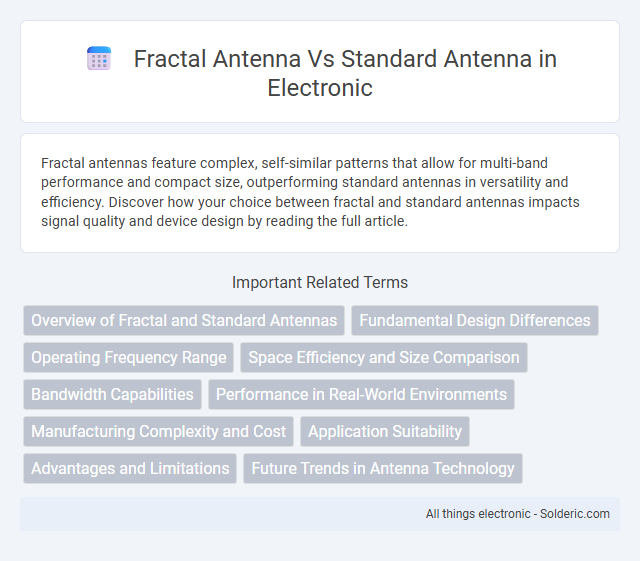Fractal antennas feature complex, self-similar patterns that allow for multi-band performance and compact size, outperforming standard antennas in versatility and efficiency. Discover how your choice between fractal and standard antennas impacts signal quality and device design by reading the full article.
Comparison Table
| Feature | Fractal Antenna | Standard Antenna |
|---|---|---|
| Design | Complex, self-similar fractal geometry | Simple, traditional shapes (dipole, monopole) |
| Size | Compact, reduced physical size | Larger, conventional dimensions |
| Frequency Range | Wideband/multiband capability | Narrowband, designed for fixed frequency |
| Bandwidth | Broad bandwidth | Narrow bandwidth |
| Performance | Efficient in multiple frequency bands | Optimized for single frequency band |
| Manufacturing | More complex, requires precision | Standard manufacturing process |
| Applications | Wireless devices, compact communication systems | Broadcast, fixed frequency communications |
| Cost | Higher due to complexity | Lower, mass-produced |
| Radiation Pattern | Multidirectional or customizable | Usually directional or omnidirectional |
Overview of Fractal and Standard Antennas
Fractal antennas utilize self-similar, repeating geometric patterns to achieve compact size and multiband performance, enhancing signal reception and transmission across diverse frequencies. Standard antennas, such as dipoles and monopoles, typically feature simple linear or planar designs optimized for a single or narrow frequency range, limiting their versatility. The fractal design increases the effective electrical length within a smaller physical footprint, enabling improved bandwidth and gain compared to traditional standard antennas.
Fundamental Design Differences
Fractal antennas use self-similar, repeating geometric patterns to maximize the antenna's effective length within a compact space, enhancing multi-band and wideband performance. Standard antennas typically rely on linear or simple geometric shapes with sizes proportional to specific wavelengths, limiting their frequency range and bandwidth. Understanding these fundamental design differences helps optimize Your antenna choice based on desired frequency versatility and spatial constraints.
Operating Frequency Range
Fractal antennas offer a significantly wider operating frequency range compared to standard antennas due to their self-similar, repeating geometry that supports multiband and broadband signal reception. Standard antennas typically operate efficiently within a narrow frequency band, limiting their versatility in applications requiring multiple frequency bands. The unique design of fractal antennas enables compact size and enhanced performance across diverse frequencies, making them ideal for modern wireless communication systems.
Space Efficiency and Size Comparison
Fractal antennas offer superior space efficiency due to their self-similar, recursive design, allowing them to occupy significantly less physical area than standard antennas while maintaining comparable performance. Their compact size enables integration into smaller devices without compromising signal quality or bandwidth. Standard antennas typically require larger dimensions to achieve similar frequency ranges, making fractal antennas ideal for modern applications demanding miniaturization and multi-band capabilities.
Bandwidth Capabilities
Fractal antennas exhibit significantly enhanced bandwidth capabilities compared to standard antennas due to their complex, self-similar geometries that enable multi-frequency resonance and miniaturization. Their design allows operation over a broader range of frequencies, making them ideal for applications requiring wideband or multiband functionality, such as wireless communication and radar systems. Standard antennas generally have narrower bandwidths, limiting their performance to specific frequency bands and reducing versatility in dynamic signal environments.
Performance in Real-World Environments
Fractal antennas exhibit enhanced performance in real-world environments due to their multi-band and wideband capabilities, allowing better signal reception across diverse frequency ranges compared to standard antennas. Their self-similar, complex geometric shapes improve impedance matching and reduce signal distortion in urban and obstructed settings, leading to more reliable connectivity. Standard antennas often struggle with interference and limited bandwidth, making fractal designs superior for applications requiring consistent performance in dynamic or cluttered environments.
Manufacturing Complexity and Cost
Fractal antennas feature intricate geometric patterns that increase manufacturing complexity compared to standard antennas, often requiring advanced fabrication techniques like photolithography or precision etching. These complexities typically raise production costs, making fractal antennas more expensive to manufacture, especially for large-scale applications. You should weigh the performance benefits against these higher costs when choosing between fractal and standard antenna designs.
Application Suitability
Fractal antennas excel in compact and multi-band applications due to their self-similar design, making them highly suitable for modern wireless devices requiring space-saving and frequency agility. Standard antennas are often preferred in single-band, high-power transmission scenarios like broadcasting or radar systems, where size and frequency flexibility are less critical. Your choice depends on whether you need versatility and miniaturization or robust, focused performance for specific frequency ranges.
Advantages and Limitations
Fractal antennas offer significant advantages over standard antennas, including a compact size, wide bandwidth, and multiband frequency capabilities due to their self-similar geometric patterns. These antennas provide enhanced signal reception and efficiency in limited space applications, making them ideal for modern devices requiring miniaturization. However, limitations include complex design and fabrication processes, potential performance variability at higher frequencies, and generally higher production costs compared to traditional antennas.
Future Trends in Antenna Technology
Fractal antennas, leveraging complex self-similar patterns, offer enhanced multi-band performance and miniaturization compared to standard antennas, shaping future trends in wireless communication. Advancements in materials such as metamaterials and flexible substrates will further amplify fractal antenna efficiency and integration into compact devices. Emerging 5G and IoT ecosystems necessitate antennas with wide bandwidth and adaptability, positioning fractal designs as a cornerstone for next-generation antenna technology development.
fractal antenna vs standard antenna Infographic

 solderic.com
solderic.com